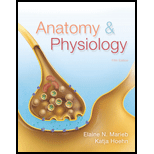
Name one organ of the alimentary canal found in the thorax. Name three organs located in the abdominal cavity.
To review:
The name of the alimentary canal organ present in the thorax region, and the three different organs that are present in the abdominal cavity.
Introduction:
The digestive organscan be categorized into two groups, namely, the alimentary canal and the accessory organs. The alimentary canal, is also referred to as the GI tract (gastrointestinal tract). It is the continuous muscular tube, extending from the mouth to the anus. It helps in digestion and absorption of food.
Explanation of Solution
Esophagus or the food pipe is the organ of the alimentary canal that is present in the thorax. The walls of the esophagus contain smooth muscles, which helps in peristaltic movement. Peristalsis is the movement caused by the alternate relaxation and contraction waves of the circulatory and longitudinal muscles, which aids in the forward movement of the food, that is, towards the stomach.
The 3 organs found in the abdominal cavity areas follows:
1. Stomach: It is a J-shaped bag-like structure, which helps in the temporary storage and mechanical distribution offood before it is movedinto the intestine. The walls of the stomach can expand or contract based on the presence of food and secreted gastric juices.
2. Small intestine: It is a long and highly coiled tube consisting of 3 regions, namely, duodenum, jejunum, and ileum. Food from the stomach is passed into the small intestine and most of the absorption process takes place in this region. The walls of the small intestine have finger-like projections, called microvilli, for the absorption of food.
3. Large intestine: It consists of 3 regions, namely, cecum, colon, and rectum. Food from the small intestine moves to this region. The absorption of water and electrolytes occurs in the large intestine and fecal matter is stored in this regionuntil it is expelled out from the body.
Therefore, it can be concluded that the esophagus (present in the thorax), stomach, small intestine, and the large intestine constitute the alimentary canal and participate in the processing and absorption of food in the body.
Want to see more full solutions like this?
Chapter 22 Solutions
Anatomy & Physiology
- Outline the negative feedback loop that allows us to maintain a healthy water concentration in our blood. You may use diagram if you wisharrow_forwardGive examples of fat soluble and non-fat soluble hormonesarrow_forwardJust click view full document and register so you can see the whole document. how do i access this. following from the previous question; https://www.bartleby.com/questions-and-answers/hi-hi-with-this-unit-assessment-psy4406-tp4-report-assessment-material-case-stydu-ms-alecia-moore.-o/5e09906a-5101-4297-a8f7-49449b0bb5a7. on Google this image comes up and i have signed/ payed for the service and unable to access the full document. are you able to copy and past to this response. please see the screenshot from google page. unfortunality its not allowing me attch the image can you please show me the mathmetic calculation/ workout for the reult sectionarrow_forward
- Skryf n kortkuns van die Egyptians pyramids vertel ñ story. Maximum 500 woordearrow_forward1.)What cross will result in half homozygous dominant offspring and half heterozygous offspring? 2.) What cross will result in all heterozygous offspring?arrow_forward1.Steroids like testosterone and estrogen are nonpolar and large (~18 carbons). Steroids diffuse through membranes without transporters. Compare and contrast the remaining substances and circle the three substances that can diffuse through a membrane the fastest, without a transporter. Put a square around the other substance that can also diffuse through a membrane (1000x slower but also without a transporter). Molecule Steroid H+ CO₂ Glucose (C6H12O6) H₂O Na+ N₂ Size (Small/Big) Big Nonpolar/Polar/ Nonpolar lonizedarrow_forward
- what are the answer from the bookarrow_forwardwhat is lung cancer why plants removes liquid water intead water vapoursarrow_forward*Example 2: Tracing the path of an autosomal dominant trait Trait: Neurofibromatosis Forms of the trait: The dominant form is neurofibromatosis, caused by the production of an abnormal form of the protein neurofibromin. Affected individuals show spots of abnormal skin pigmentation and non-cancerous tumors that can interfere with the nervous system and cause blindness. Some tumors can convert to a cancerous form. i The recessive form is a normal protein - in other words, no neurofibromatosis.moovi A typical pedigree for a family that carries neurofibromatosis is shown below. Note that carriers are not indicated with half-colored shapes in this chart. Use the letter "N" to indicate the dominant neurofibromatosis allele, and the letter "n" for the normal allele. Nn nn nn 2 nn Nn A 3 N-arrow_forward
 Human Biology (MindTap Course List)BiologyISBN:9781305112100Author:Cecie Starr, Beverly McMillanPublisher:Cengage Learning
Human Biology (MindTap Course List)BiologyISBN:9781305112100Author:Cecie Starr, Beverly McMillanPublisher:Cengage Learning Human Physiology: From Cells to Systems (MindTap ...BiologyISBN:9781285866932Author:Lauralee SherwoodPublisher:Cengage Learning
Human Physiology: From Cells to Systems (MindTap ...BiologyISBN:9781285866932Author:Lauralee SherwoodPublisher:Cengage Learning





